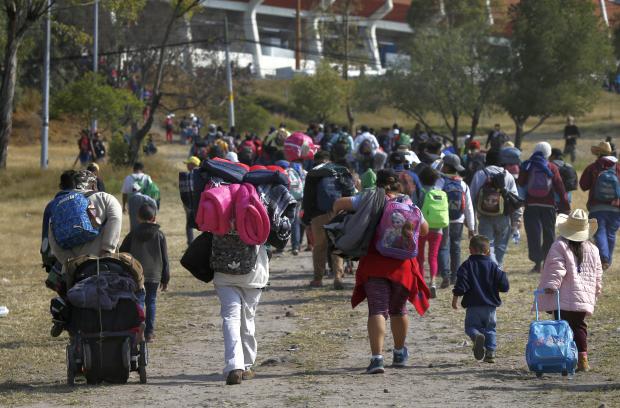Migrant caravan heads north after departing Mexico City

Central American migrants arrive in Queretaro, Mexico, as they resume their journey north after leaving the temporary shelter in Mexico City, Saturday, Nov. 10, 2018. Thousands of Central American migrants were back on the move toward the U.S. border Saturday, after dedicated Mexico City metro trains whisked them to the outskirts of the capital and drivers began offering rides north. (Photo by MARCO UGARTE / AP)
MEXICO CITY — Thousands of Central American migrants set up tents and strung tarps at a stadium in the central Mexican city of Queretaro, where they arrived Saturday afternoon after departing the country’s capital at dawn on their long trek to the U.S. border.
Their day began with dedicated Mexico City metro trains whisking them to the outskirts of the capital. At the end of the metro line, migrants began making their way to a main highway to resume walking and hitching rides with the tacit approval of Mexican officials.
READ: Mexico torn between stopping, aiding migrant caravan
Near a major toll plaza about 19 miles (30 kilometers) north of the city, Mexico state police and human rights officials helped load men, women and children onto eighteen-wheelers and asked passing buses and trucks if they would carry migrants.
Maria Yesenia Perez, a 41-year-old who left La Ceiba, Honduras nearly a month ago with her 8-year-old daughter, said she was prepared to wait to gain entry at the U.S. border.
“I decided to come (with the caravan) to help my family,” she said, before she and her daughter were hoisted onto the back of a semitrailer.
Article continues after this advertisementPerez is now one of roughly 4,000 migrants who proceeded to Queretaro — a state capital 124 miles (200 kilometers) to northwest of Mexico City— and then possibly to Guadalajara, Culiacan, Hermosillo and eventually Tijuana on the U.S. border.
Article continues after this advertisementWhereas migrants like her carried tiny knapsacks with bare essentials in Mexico’s tropical south, however, their belongings swelled noticeably after a multiday stop in Mexico City.
Many are now hauling bundles of blankets, sleeping bags and heavy clothing to protect against colder temperatures in the northern part of the country.
Some left the capital with bottles of water and clear plastic bags of bananas and oranges for the long trek. Others were given juice and ham sandwiches from volunteers as they set out.
Astrid Daniela Aguilar, who was traveling with two cousins aged 3 and 4, lined up alongside the highway to await a chance at hitching a ride.
“You can’t find work there,” she said of her home country of Honduras.
When they arrived in the stadium that Queretaro officials had prepared for them, they began getting ready for the night. Some set up tents, others found shelter beneath its concourse.
Volunteers offered sandwiches, tortillas and rice to the travelers.
The caravan planned to leave Queretaro for Irapuato about 100 kilometers (62 miles) to the west at 5 a.m. Sunday.
The caravan became a campaign issue in U.S. midterm elections and U.S. President Donald Trump has ordered the deployment of over 5,000 military troops to the border to fend off the migrants. Trump has also insinuated without proof that there are criminals or even terrorists in the group.
READ: ‘We are not killers’: Migrants in caravan respond to Trump
Many migrants say they are fleeing rampant poverty, gang violence and political instability primarily in the Central American countries of Honduras, Guatemala, El Salvador and Nicaragua, and they have now been on the road for weeks.
On Thursday, the U.N. rejected a demand by caravan representatives for buses to the border, saying its agencies were “unable to provide the transportation demanded by some members of the caravan.”
Mexico City is more than 600 miles from the nearest U.S. border crossing at McAllen, Texas, but the area around the Mexican border cities of Reynosa, Matamoros and Nuevo Laredo is rife with drug gangs and the migrants consider it too risky.
Migrants are now taking a still perilous, but somewhat safer and longer route to Tijuana in Mexico’s far northwest, across from San Diego.
Mexico has offered refuge, asylum or work visas to the migrants, and its government said 2,697 temporary visas had been issued to individuals and families to cover them while they wait for the 45-day application process for a more permanent status.
But most vowed to continue to the United States.
READ: Migrant caravan members reject offer to stay in Mexico
Giselle Owen, a 15-year-old from San Pedro Sula, Honduras, belted out romantic ballads as the day’s journey got underway.
“It relaxes me and I feel like I don’t get tired,” she said. “I can walk hours singing.”
Others got ahead by taking rides from friendly Mexicans.
Angelica Martinez saw David Rodriguez pushing his friend Rafael Peralta of San Pedro Sula, Honduras down the side of the highway in a wheelchair.
She stopped in a lane of the highway to load the two migrants and the wheelchair into her small Volkswagen hatchback and said she would take them as far as she was going up the road. /atm